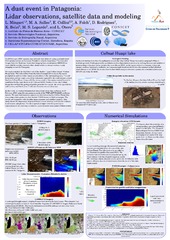A dust event in Patagonia : Lidar observations, satellite data and modeling
Autores

Resumen
On 20 February 2016, mineral dust aerosols were detected using a ground-based
lidar system located at Comodoro Rivadavia airport (Argentina). The true-color
images from the Moderate Resolution Imaging Spectroradiometer (MODIS) on
board AQUA satellite showed a dust cloud carried by strong westerly winds
sweeping across the Patagonia.
We concluded that the dust blew out of the shallow "Lago Colhué Huapi" (Colhué
Huapi lake). This lake suffers from the lack of enough inflow due to the scarce
precipitation and the water intake constructions in the surrounding area. The soil
desiccation and the larger area of the sediments exposed to the wind erosion around
the lake Colhué Huapi along with the strong winds of the region created favorable
conditions for the dust storm on 20 February 2016. Studies on the lake Colhué
Huapi showed that the geological profile presents two layers: the lowest pyroclasticsedimentary
and the higher of volcanic characteristics (vulcanites).
In this work, we conducted numerical simulations of the dust outbreak on 20
February 2016 using the resuspension mode of the WRF-ARW/FALL3D modeling
system. The potential emission sources are determined by the Colhué Huapi lake
area using a total grain size distribution (TGSD) based on field campaigns. The
results are compared with the lidar measurements and satellite imagery. This
study shows the importance of ground-based remote sensing instruments to detect
dust/volcanic ash plumes. The development of algorithms for quantitative
comparisons is the next step to achieve a more accurate assessment of these events.
Descripción
Póster presentado en Cities on Volcanoes 9, del 20 al 25 de Noviembre de 2016 en Puerto varas, Chile.